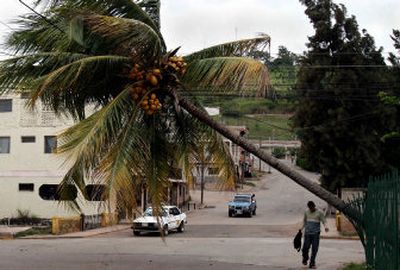Beta weakens after hitting Nicaragua

MANAGUA, Nicaragua – Central American leaders were breathing cautious sighs of relief Sunday after Hurricane Beta slammed into Nicaragua’s east coast on Sunday but rapidly weakened to a tropical storm, promising to exit their territory without causing the massive injuries and deaths left by Hurricane Mitch seven years ago.
But they also were realistic about the serious damage Beta caused and the potentially deadly disasters it might still provoke as it dumped relentless heavy rains over the region, ripping off roofs, toppling trees and flooding low neighborhoods.
In Honduras, authorities evacuated more than 7,800 people Sunday from 50 communities north of the Nicaraguan border after four rivers overflowed from 4 inches of rain brought by Beta. Strong winds cut off power and communication in hundreds of communities and flooding damaged farm crops.
“We are facing serious danger from the rain,” Honduran President Ricardo Maduro told reporters Sunday. “We are staying on alert in nearly every part of the nation.”
Beta came ashore Sunday near the remote Nicaraguan town of Sandy Bay Sirpi, 200 miles northeast of Managua, as a category 2 hurricane with 105 mph winds, according to the National Hurricane Center in Miami.
By midafternoon, it had weakened to a tropical storm and its maximum sustained winds decreased to some 40 mph in the evening as it moved inland, dumping up to 15 inches of rain. Beta was expected to continue losing strength and weaken to a tropical depression overnight before dissipating.
In Nicaragua’s northern city of Puerto Cabezas, 10 people were reported missing after their boat disappeared as they tried to escape the storm, Mayor Gustavo Ramos said. But emergency officials said they were later found alive.
Jack Howard, the mayor of the central coastal town of Laguna de Perlas, told local television that 700 people were trapped in the coastal town of Tasbapauni, separated by a lagoon from the rest of the mainland, because they lacked fuel for their boats.
“No one was injured, no one was killed, thank God,” Nicaraguan President Enrique Bolanos said. “We are prepared from coast to coast.”
The National Hurricane Center predicted that Beta would produce from 10 to 15 inches of rain across Nicaragua and eastern Honduras, with up to 25 inches possible in some areas. “These rains could cause life-threatening flash floods and mudslides,” the center said.
Nicaragua’s Education Minister Miguel Angel Garcia suggested that people in low-lying areas take refuge in schools until the storm completely passed. Classes remained suspended until further notice.